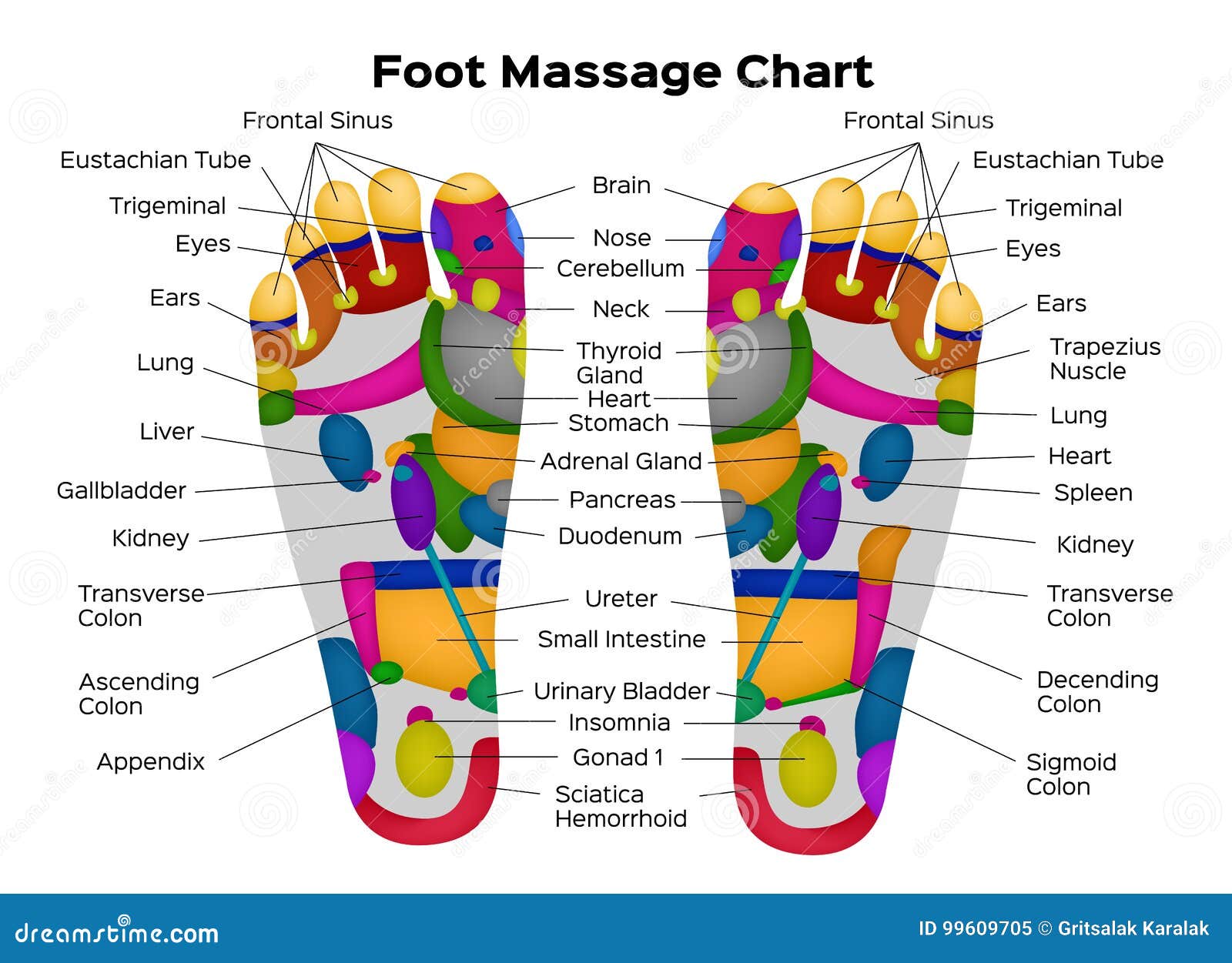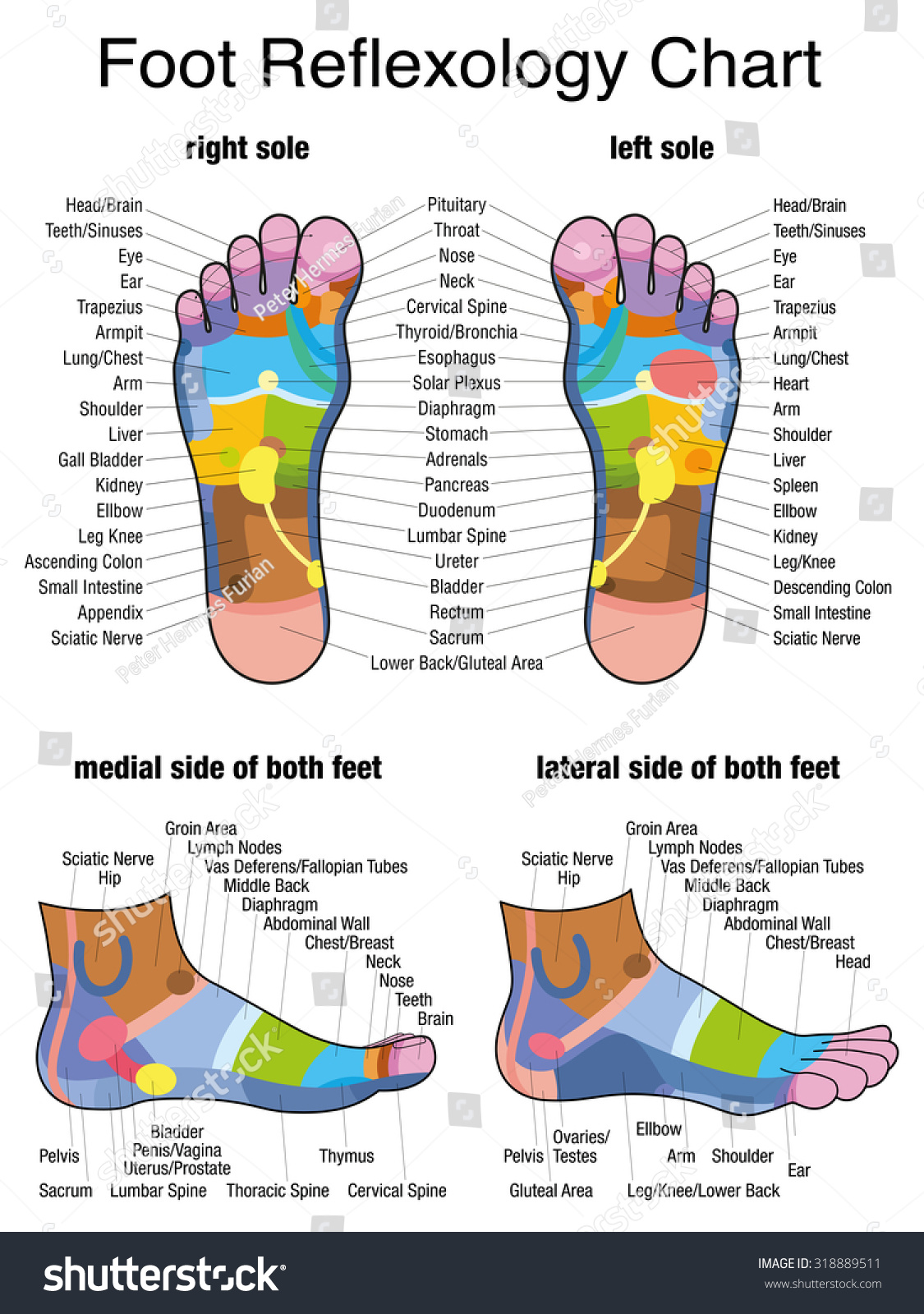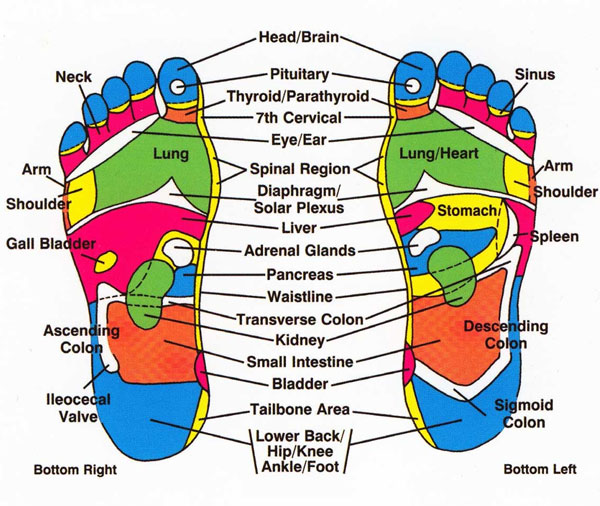
Foot Reflexology Chart with Description of the Internal Organs and Body
Common causes of foot pain include plantar fasciitis, bunions, flat feet, heel spurs, mallet toe, metatarsalgia, claw toe, and Morton's neuroma. If your feet hurt, there are effective ways to ease the pain. Some conditions specific to the foot can cause pain, less movement, or instability. Verywell / Alexandra Gordon.

Foot reflexology chart with accurate description of the corresponding
Foot reflexology chart. A foot reflexology chart shows the acupressure points on the feet soles and their link to organs. . Foot reflexology chart in different styles, that illustrate the acupressure points /reflex zones on the feet soles and their link to organs.

Foot reflexology chart and internal organs Reflexology foot chart
To start a foot reflexology massage, begin with the toes. You should massage with the rotating thumb technique. Using your thumbs, press in, rotate, lift, and then move, focusing on covering only small areas of the body at a time. Massage the both feet. Move on to the tops and sides of your feet.

Reflexology👣Areas On Your Feet That Practitioners Believe Correspond
This outlines the major organs locations on the foot. The right foot is associated with the right part of the body and left foot is associated with the left side of the body.. find whatever part of the body that you want to activate and work on and apply the treatment there like a map. Advertisement. 3. Learn about a sole chart.

Reflexology Treatment What it reflexology and how can it help you?
Let's take a look at this foot reflexology chart. Image source. Each zone of the foot massage chart corresponds to a specific organ. The right foot corresponds to the right side of the body and the left to the left. The pads of the four nail phalanges of the toes (except for the pads of the thumbs) are associated with the frontal and.

Foot reflexology chart inside and outside view of the feet with
Summary. The foot is an intricate part of the body, consisting of 26 bones, 33 joints, 107 ligaments, and 19 muscles. Scientists group the bones of the foot into the phalanges, tarsal bones, and.

Reflexology Foot Map — Hitchin Reflexology
Bones of foot. The 26 bones of the foot consist of eight distinct types, including the tarsals, metatarsals, phalanges, cuneiforms, talus, navicular, and cuboid bones. The skeletal structure of.

Foot Reflexology Chart What Is It and How Do I Use It? PureWow
As we have discussed, one reflexology foot chart may differ slightly from another - there are numerous versions of reflexology foot maps out there. They will all have organs and body parts in similar places, but some may be more detailed than others including a greater number of regions. Here are some more examples of foot reflexology charts:

Vector Illustration of Soles of Feet with Marked by Reflexology Zones
Reflexology is a form of massage with roots that go back to ancient Chinese medicine. The technique used relies upon a map of the feet, which identifies pressure points that supposedly correspond to certain organs and muscles in the body and can even be used to stimulate the endocrine and nervous system. In other words, reflexology is basically.

Reflex Zones Of The Feet Soles And Side Views Accurate Description
Familiarize yourself with the basic foot reflexology chart. Starting out, learn about the basic areas on a foot reflexology chart. This outlines the major organs locations on the foot. The right foot is associated with the right part of the body and left foot is associated with the left side of the body.

Reflexology Foot Map r/reflexology
The location of the reflexes for every organ in the body can be seen on the reflexology foot map. Some reflexes, such as the heart on the left foot and the liver on the right, appear on only one foot. This is because there is only one of each organ and they lie on that side of the body. In many instances, there are matching points on both feet.

Reflexology, feet, hands, ears, connection, organ pain from the feet
The foot is a part of vertebrate anatomy which serves the purpose of supporting the animal's weight and allowing for locomotion on land. In humans, the foot is one of the most complex structures in the body. It is made up of over 100 moving parts - bones, muscles, tendons, and ligaments designed to allow the foot to balance the body's.

Reflexology Foot Map, Artwork Photograph by Peter Gardiner Pixels
Foot reflexology is an ancient practice that aims to improve medical conditions by using specific pressure on your feet. A foot reflexology chart is designed as a map of the spots you need to.

The Foot Understanding Zones & Reflexes Women Fitness
The muscles of the foot are located mainly in the sole of the foot and divided into a central (medial) group and a group on either side (lateral). The muscles at the top of the foot fan out to supply the individual toes. The tendons in the foot are thick bands that connect muscles to bones. When the muscles tighten (contract) they pull on the.

Foot reflexology chart medialinside and lateraloutside view of the
Foot Reflexology Sole Chart. The foot reflexology sole map is comparatively really easy to understand and learn. It mentions the body organs exactly the way they are inside the body. It covers your eyes, ears, lungs, heart, stomach, solar plexus, spleen, teeth, top of the head, pancreas and your entire legs.

Foot Reflexology Chart Accurate Description Corresponding Stock Vector
Anatomy is a road map. Most structures in the foot are fairly superficial and can be easily palpated. Anatomical structures (tendons, bones, joints, etc) tend to hurt exactly where they are injured or inflamed. Therefore a basic understanding of surface anatomy allows the clinician to quickly establish the diagnosis or at least narrow the.